Lucy Parker Telles (1870-1956) was of Yosemite Miwok and Mono Lake Paiute descent. Shortly after her son Lloyd was born in 1902, her husband Jack Parker, Paiute, died. Miwok and Paiute peoples of the Yosemite area had begun to find new occupations with the influx of tourists and status of Yosemite valley as a National Park: guides, domestics. Traditional lifeways were partially supplanted by a money economy, with purchased beans, coffee, white bread and purchased cloth supplementing the traditional acorn and fish. To support her family, Lucy turned to basket weaving, which she had learned as a child. Her innovations had a large and continuing influence on the styles of Yosemite weavers. She modified traditional Miwok shapes. More importantly, she began to use 2 colors where by tradition only one per basket -- either black from bracken fern root or red from split redbud twigs -- had been used. She adapted motifs from the showy Plains beadwork that was just reaching the area. Her designs were large, often had stylized pictorial elements arranged in overall symmetric patterns, making the whole basket surface one unified design, like the high-shoulder gift basket shown above whose price seems astonishingly low now, but was high for the early 1900's. By the 1920's, she was acknowledged as the best weaver in the valley, and other women were copying the style innovations she had introduced.
In the early 1920's, the Yosemite Park Service became interested in encouraging basketry among the Indian women of the valley. They started holding "Indian Field Days," a social get-together in which basketry judging was the centerpiece. Indian families enjoyed the occasion, and the women learned much from each other -- especially design ideas -- in showings and conversations at these doings.
In 1929, Lucy Telles began a basket project that was to take her 4 years -- the giant basket shown above, which was later to win first prize at the 1939 World's Fair. It's one of the largest, perhaps the largest, fine basket ever made. Other women also decided to start big, long-term baskets, in hopes that when better times came again, they would have these very impressive art works of years to show. Lucy kept her large prizewinner. Around 1950, she raffled it off. Her son won it, and the National Park Service later purchased it for the Yosemite Museum..
From 1947 on. Lucy Telles demonstrated basket waving at Yosemite, as tourism began to pick up after World War II. Her grandson Ralph brought his wife, Julia Pete Parker (Kashia Pomo) to live in the Valley, where she worked in the Park laundry. Julia had had a hard childhood, moving around with her migrant farm worker parents, until put in a BIA boarding school in Nevada after their deaths when she was 6. Lucy taught Julia, who was interested in preserving Indian culture, Miwok-Paiute traditions, and the skills of basketry. Julia helped to support her 4 children and 9 grandchildren by selling baskets. After Lucy Telles died in 1956, the Park Service asked Julia Parker to take over as a cultural demonstrator. She continued her studies with Carrie Bethel, Minnie Mike and Ida Bishop (local Miwok-Paiutes), and later studied Pomo basketry with Pomo master weaver Elsie Allen at Ukiah and several others. As cultural demonstrator and supervisor of th program, Parker has been a key figure in preserving games, tools, foods of the traditional heritage, as well as basketry. She teaches classes and demonstrations at Yosemite, many elementary schools, colleges and museums. She has been featured in documentary videos of the traditional culture, and is writing a book about it.
So it continues, through a few talented and dedicated women -- the tradition of Native basketry that is inspired by and complements Yosmite's beauties of nature (that are somewhat trammeled by the hordes of visitors). | |
|---|---|
| Continue -- Pomo Feather, bead gift baskets | |

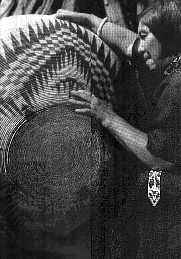
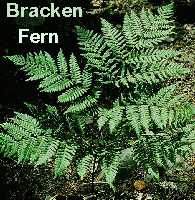 Roots of bracken fern (Pteridum aquilinum), sometimes called fiddlehead, whose scrolled young shoots are edible in early spring, form shades of dark brown and black, when dyed by being buried in mud or left to soak in rusty tin cans. Can lids with holes of various sizes made good tools to scrape the willow and redbud twigs uniform in size. Metal awls, knives and scissors also helped make finer basketry possible. The women traded for sedge with longer roots than grew in the stony soil of Yosemite valley. Sedge roots formed the yellow-white background weft of their baskets.
Roots of bracken fern (Pteridum aquilinum), sometimes called fiddlehead, whose scrolled young shoots are edible in early spring, form shades of dark brown and black, when dyed by being buried in mud or left to soak in rusty tin cans. Can lids with holes of various sizes made good tools to scrape the willow and redbud twigs uniform in size. Metal awls, knives and scissors also helped make finer basketry possible. The women traded for sedge with longer roots than grew in the stony soil of Yosemite valley. Sedge roots formed the yellow-white background weft of their baskets.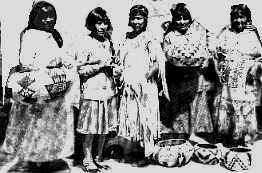 The last Indian Field Day was held in 1929. Basketry competition winners (left to right) photographed then are Tina Charlie, Carrie Bethel, Alice (James) Wilson, Leanna Tom, and Maggie Tabuce Howard. They hold their winning baskets, some displayed at their feet. But the Depression was beginning. Tourism dropped sharply until after World War II. This was the last Indian Field Days held at Yosemite.
The last Indian Field Day was held in 1929. Basketry competition winners (left to right) photographed then are Tina Charlie, Carrie Bethel, Alice (James) Wilson, Leanna Tom, and Maggie Tabuce Howard. They hold their winning baskets, some displayed at their feet. But the Depression was beginning. Tourism dropped sharply until after World War II. This was the last Indian Field Days held at Yosemite.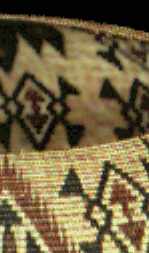
 Carrie Bethel began this large 30" diameter basket in 1931, finishing it in 1935. Its complex design and fine coil stitching brought a price of $100, said to have been the highest price paid to that date for Yosemite weavers' baskets. (It is in the National Park Service Collection.) Unlike other California weavers, Miwok-Paiute women concentrated on tiny rod foundations, as well as close coil stitching, an overall effect of great fineness, as well as doubling or tripling the amount of work.
Carrie Bethel began this large 30" diameter basket in 1931, finishing it in 1935. Its complex design and fine coil stitching brought a price of $100, said to have been the highest price paid to that date for Yosemite weavers' baskets. (It is in the National Park Service Collection.) Unlike other California weavers, Miwok-Paiute women concentrated on tiny rod foundations, as well as close coil stitching, an overall effect of great fineness, as well as doubling or tripling the amount of work.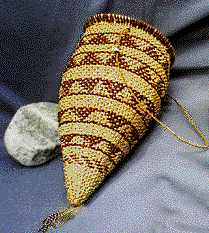 Julia Parker continues the Yosemite basketry tradition. Left is a miniature 10" x 5" burden basket, worn at the waist, for gathering willow or redbud twigs. with a foundation of willow and the usual background of sedge roots. The pattern is redbud. It's been given a coating of soaproot juice to protect it in the bush,
Julia Parker continues the Yosemite basketry tradition. Left is a miniature 10" x 5" burden basket, worn at the waist, for gathering willow or redbud twigs. with a foundation of willow and the usual background of sedge roots. The pattern is redbud. It's been given a coating of soaproot juice to protect it in the bush,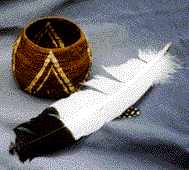 Colored entirely with redbud twigs, this tiny (5" diameter by 3.75" high) Pomo-tradition gift basket has Julia's flame pattern made in the dark red twigs that are stripped in winter for darkest red color.
Colored entirely with redbud twigs, this tiny (5" diameter by 3.75" high) Pomo-tradition gift basket has Julia's flame pattern made in the dark red twigs that are stripped in winter for darkest red color.